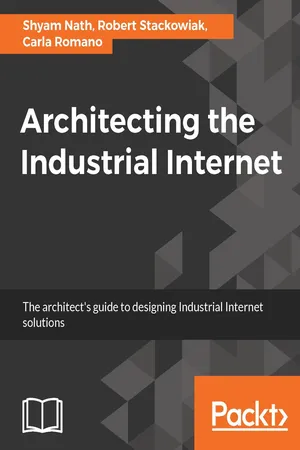
- 360 pages
- English
- ePUB (mobile friendly)
- Available on iOS & Android
Architecting the Industrial Internet
About this book
Learn the ins and outs of the Industrial Internet of Things through subjects ranging from its history and evolution, right up to what the future holds.About This Book• Define solutions that can connect existing systems and newer cloud-based solutions to thousands of thousands of edge devices and industrial machines• Identify, define, and justify Industrial Internet of Things (IIoT) projects, and design an application that can connect to and control thousands of machines• Leverage the power and features of a platform to monitor, perform analytics, and maintain the Industrial InternetWho This Book Is ForArchitects who are interested in learning how to define solutions for the Industrial Internet will benefit immensely from this book. Relevant architect roles include enterprise architects, business architects, information architects, cloud solution architects, software architects, and others. The content is also relevant for technically inclined line of business leaders investing in these solutions.What You Will Learn• Learn the history of the Industrial Internet and why an architectural approach is needed• Define solutions that can connect to and control thousands of edge devices and machines• Understand the significance of working with line of business leadership and key metrics to be gathered• Connect business requirements to the functional architecture• Gain the right expectation as to the capabilities of Industrial Internet applications and how to assess them• Understand what data and analytics components should be included in your architecture solution• Understand deployment trade-offs, management and security considerations, and the impact of emerging technologiesIn DetailThe Industrial Internet or the IIoT has gained a lot of traction. Many leading companies are driving this revolution by connecting smart edge devices to cloud-based analysis platforms and solving their business challenges in new ways. To ensure a smooth integration of such machines and devices, sound architecture strategies based on accepted principles, best practices, and lessons learned must be applied.This book begins by providing a bird's eye view of what the IIoT is and how the industrial revolution has evolved into embracing this technology. It then describes architectural approaches for success, gathering business requirements, and mapping requirements into functional solutions. In a later chapter, many other potential use cases are introduced including those in manufacturing and specific examples in predictive maintenance, asset tracking and handling, and environmental impact and abatement. The book concludes by exploring evolving technologies that will impact IIoT architecture in the future and discusses possible societal implications of the Industrial Internet and perceptions regarding these projects.By the end of this book, you will be better equipped to embrace the benefits of the burgeoning IIoT.Style and approachThis book takes a comprehensive approach to the Industrial Internet, thoroughly acquainting the reader with the concepts and philosophy of the IIoT. It provides a basis for defining an IIoT solution in a thoughtful manner and creating what will be viewed as a successful project.
Frequently asked questions
- Essential is ideal for learners and professionals who enjoy exploring a wide range of subjects. Access the Essential Library with 800,000+ trusted titles and best-sellers across business, personal growth, and the humanities. Includes unlimited reading time and Standard Read Aloud voice.
- Complete: Perfect for advanced learners and researchers needing full, unrestricted access. Unlock 1.4M+ books across hundreds of subjects, including academic and specialized titles. The Complete Plan also includes advanced features like Premium Read Aloud and Research Assistant.
Please note we cannot support devices running on iOS 13 and Android 7 or earlier. Learn more about using the app.
Information
Defining a Deployment Architecture
- Past and current deployment architectures
- On-premises or cloud deployment
- Design for edge tier
- Networking considerations
- Device management
- Management and support infrastructure
- Consumption models
Current state of deployment architectures for IT systems


Hosted systems and the cloud
Hosted services
Table of contents
- Title Page
- Copyright
- Credits
- About the Authors
- About the Reviewers
- www.PacktPub.com
- Customer Feedback
- Preface
- The Industrial Internet Revolution
- Architectural Approaches for Success
- Gathering Business Requirements
- Mapping Requirements to a Functional Viewpoint
- Assessing Industrial Internet Applications
- Defining the Data and Analytics Architecture
- Defining a Deployment Architecture
- Securing the Industrial Internet
- Governance and Assuring Compliance
- Industrial Internet Use Cases in Various Industries
- A Vision of the Future
- Sources